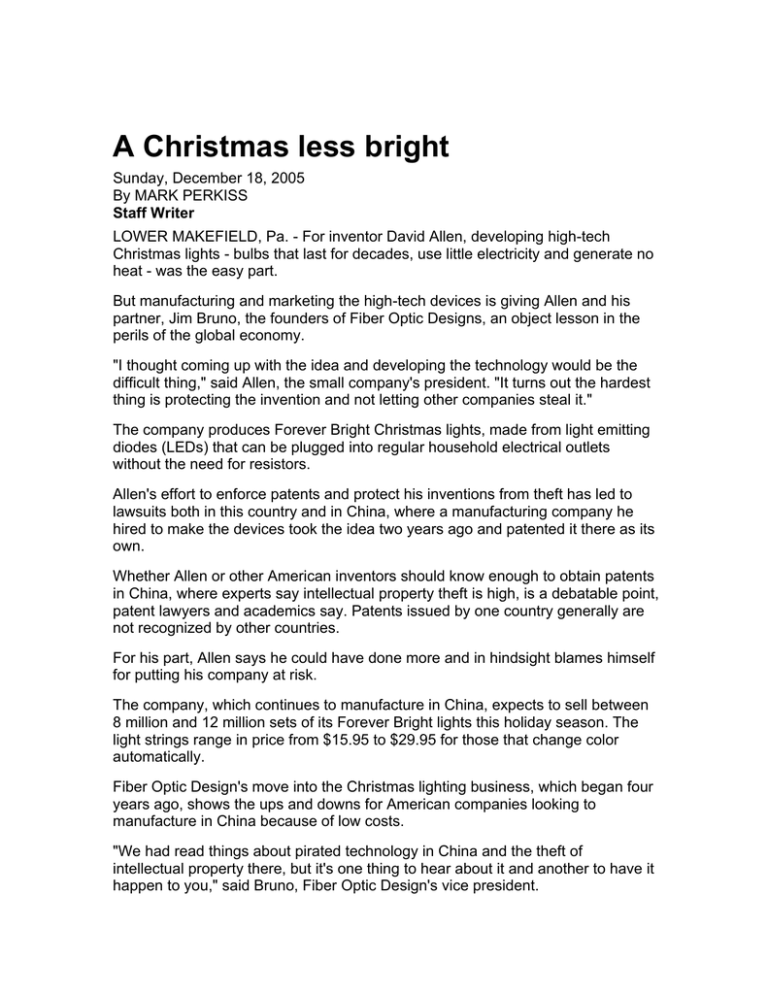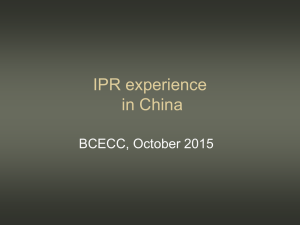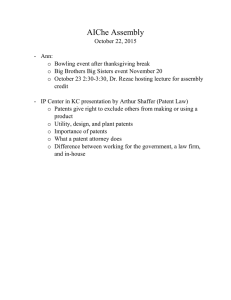
A Christmas less bright
Sunday, December 18, 2005
By MARK PERKISS
Staff Writer
LOWER MAKEFIELD, Pa. - For inventor David Allen, developing high-tech
Christmas lights - bulbs that last for decades, use little electricity and generate no
heat - was the easy part.
But manufacturing and marketing the high-tech devices is giving Allen and his
partner, Jim Bruno, the founders of Fiber Optic Designs, an object lesson in the
perils of the global economy.
"I thought coming up with the idea and developing the technology would be the
difficult thing," said Allen, the small company's president. "It turns out the hardest
thing is protecting the invention and not letting other companies steal it."
The company produces Forever Bright Christmas lights, made from light emitting
diodes (LEDs) that can be plugged into regular household electrical outlets
without the need for resistors.
Allen's effort to enforce patents and protect his inventions from theft has led to
lawsuits both in this country and in China, where a manufacturing company he
hired to make the devices took the idea two years ago and patented it there as its
own.
Whether Allen or other American inventors should know enough to obtain patents
in China, where experts say intellectual property theft is high, is a debatable point,
patent lawyers and academics say. Patents issued by one country generally are
not recognized by other countries.
For his part, Allen says he could have done more and in hindsight blames himself
for putting his company at risk.
The company, which continues to manufacture in China, expects to sell between
8 million and 12 million sets of its Forever Bright lights this holiday season. The
light strings range in price from $15.95 to $29.95 for those that change color
automatically.
Fiber Optic Design's move into the Christmas lighting business, which began four
years ago, shows the ups and downs for American companies looking to
manufacture in China because of low costs.
"We had read things about pirated technology in China and the theft of
intellectual property there, but it's one thing to hear about it and another to have it
happen to you," said Bruno, Fiber Optic Design's vice president.
-- -- -Allen, who devised and patented a technology that allows LED lights to be
powered by standard electrical outlets free of resistors, first turned to China and
contracted with a manufacturer there in 2000 to make his Forever Bright lights for
the 2001 Christmas season.
Where Allen made his mistake, he, patent and international trade experts say,
was not patenting his technology and light designs in China.
"We had nondisclosure agreements and that's all we thought we needed since
we weren't going to be selling the lights in China," Allen said. "We found out
those agreements were worthless."
The company's dealings with Chinese manufacturing firms began well. As U.S.
and Canadian sales of the LED lights grew, Fiber Optic Designs contracted with
a second Chinese manufacturing company and then a third to increase
production.
That third company, which Allen and Bruno refuse to name, liked Allen's design.
In fact, it liked the design so much that in 2003 it filed an application for a
Chinese patent on the lantern design of the covering of the LED lights.
Because Allen had never patented his design in China, the Chinese government
issued a patent to the manufacturer, which then sued Forever Bright, along with
its two other Chinese manufacturers, for patent infringement and attempted to
stop them from making the LED lights.
"It seems crazy, but we were sued by a company that stole our idea and then
tried to block us from making our own invention," Allen said. "I didn't think we had
a need to patent the light covering. I didn't think there was sufficient invention
involved to warrant a patent. Our U.S. patents are for circuitry, not for light
coverings."
To combat the threat, "We had to meet the extremely high standards for having
evidence introduced in Chinese courts to show we had our product on the market
before the patent in China was issued," Bruno said.
-- -- -To demonstrate prior invention of the lantern design, the company tried to submit
a copy of The Times from December 2001, which carried a story detailing the
design in question.
"The problem is, you cannot just submit the newspaper. They do not accept that
as evidence," Bruno said. "You have to get a notary to attest that it is a genuine
newspaper from the date in question," he said.
"Then, you need to get a state judge to certify that the notary is a licensed
professional in good standing. Then, you need to get a state agency to certify
that the judge you used is, in fact, a judge. Then, you need to get the U.S. State
Department to certify that the certifying state agency is legitimate. Then, you
need to get the State Department to present the document to the Chinese
embassy in Washington and you need to have the Chinese embassy certify that
it received the document from a state department official that it recognizes as
legitimate.
"If there is any break in this chain, the evidence is completely inadmissible,"
Bruno said.
"It took us eight months and many thousands of dollars to submit a single
newspaper article. We wanted to submit a video recording from a local news
channel that did a feature on us several years back, but we could not do that no
matter how many people we got to certify it. Video evidence is not admissible."
Allen said the company spent about $50,000 to successfully overturn the patent
granted to the Chinese manufacturer. He has since patented his LED lights in
China.
Patent and international trade experts agree Allen could have avoided the legal
entanglement by patenting his Christmas lights in China initially but are split on
whether he should have taken that step.
"Obviously the safest course of action is to get patents anywhere you are doing
anything with an invention to get the maximum protection," said Sabrina Safrin, a
patent and international law expert at Rutgers-Newark School of Law.
"The problem is that's a lengthy and costly process," she said. "This company
took a risk, which many companies do, in not getting a patent in every jurisdiction.
In their defense, however, you would not expect someone to patent your
invention in the country where your invention is being manufactured."
-- -- -Andrew Mertha, an international trade expert at Washington University in St.
Louis, took a harsher stance and criticized Allen. "If you're going to go into China,
where intellectual property theft has improved some but remains rampant, you
really need to be careful," he said. "This company didn't do its homework and
take precautions."
Safrin and Mertha agreed that Chinese officials' decision to revoke the patent
issued to the Chinese company is a step in the right direction and is a sign that
China is beginning to respond to Western complaints about piracy of intellectual
property.
"The ruling shows that the people making the decisions in China are getting a
more nuanced understanding of patent law and the countries with whom they're
dealing," Mertha said. "The biggest problem is there is little enforcement of
China's own patent laws, so piracy remains a big problem."
Fiber Optic Design's legal wrangling has not come to an end. The company
currently is claiming patent infringement and suing two American importing firms,
including one in Minnesota that sells its LED Christmas lights to Target, one of
the nation's largest retailers.
Attorneys for Fiber Optic Designs and Seasonal Specialties of Minneapolis say
that case, filed in U.S. District Court in Minnesota, is early in the process and no
trial date has been set.
Randall Skaar, an attorney for Seasonal Specialties, said his client's LED lights
are substantially different from those made by Fiber Optic Designs, so there is no
patent infringement.
Allen decided to get into the Christmas-light business about nine years ago
shortly after wiring his entire house with traditional bulbs and finding that many of
them didn't work properly. "I decided then that there had to be a better way to
design Christmas lights," he said.
Over the next four years, he devised a way to make Christmas lights from lightemitting diodes, which burn longer and use less electricity than incandescent
bulbs. By the 2000 season, he had hired a Chinese factory to begin making
Forever Bright lights for the U.S. market.
-- -- -Fiber Optic Designs is a privately held company and Allen and Bruno declined to
disclose annual sales figures. The company has a license agreement with
Holiday Creations of Denver to sell Forever Bright lights. Holiday Creations
officials could not be reached for comment.
With an increasingly globalized economy, negotiators for various countries are
working toward creating a worldwide patent system that could be enforced under
the World Trade Organization, but as with other trade-related issues, progress
has been very slow.
Some believe China's attitude toward patents arises from its history.
After Mao Zedong and the communists took over the country in 1949, they
abolished most forms of private property and created a patent system that
awarded all Chinese patents to the government and allowed Chinese people to
use those patents however they wanted.
China has changed that system in recent years, but many Chinese companies
still act as if the old system were in place. In just the past couple of years, a huge
number of prominent Western companies like General Motors, Cisco, Sony and
Pfizer, as well as nearly every movie studio and designer clothes makers, have
complained about Chinese patent infringement.
Experts also have noted an increasing number of cases like the one faced by
Fiber Optic Design, cases where a Chinese company patents a product that has
been around for some time - then brings patent infringement charges against its
inventor.
NOTE: Contact Mark Perkiss at mperkiss@njtimes.com or (609) 989-5723.
© 2006 The Times of Trenton
© 2006 NJ.com All Rights Reserved.


